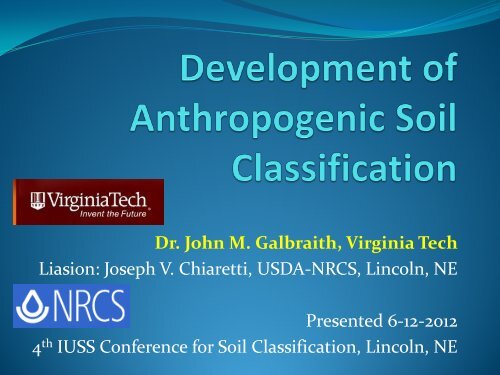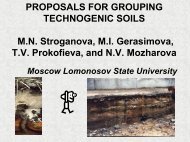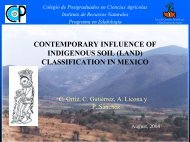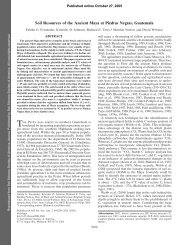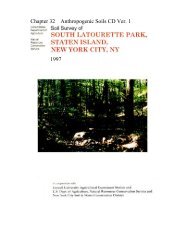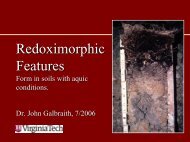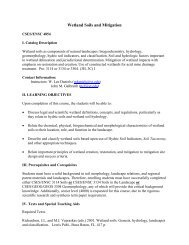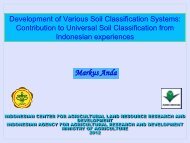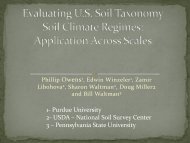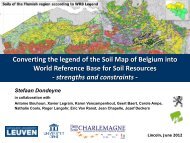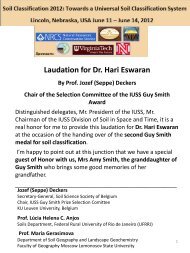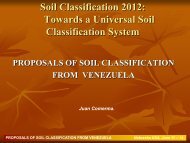Development of Anthropogenic Soil Classification - Virginia Tech
Development of Anthropogenic Soil Classification - Virginia Tech
Development of Anthropogenic Soil Classification - Virginia Tech
You also want an ePaper? Increase the reach of your titles
YUMPU automatically turns print PDFs into web optimized ePapers that Google loves.
Dr. John M. Galbraith, <strong>Virginia</strong> <strong>Tech</strong><br />
Liasion: Joseph V. Chiaretti, USDA-NRCS, Lincoln, NE<br />
Presented 6-12-2012<br />
4th IUSS Conference for <strong>Soil</strong> <strong>Classification</strong>, Lincoln, NE
Thank you, Dr. Allen
Thank you, Hari
Naming Names<br />
In summary, it would be impossible to mention all<br />
names that contributed to this final proposal.<br />
A short list includes: WRB and IUSS and FAO<br />
Del Fanning International Participants<br />
John Sencindiver Craig Ditzler<br />
Ray Bryant Steve Fisher<br />
Dick Arnold NYC <strong>Soil</strong> Survey<br />
Alan Kosse (dec.) Horace Smith<br />
Bob Ahrens Maxine Levin<br />
Bob Engel Luis Hernandez<br />
Pavel Krasilnikov John Kimble
Introduction<br />
<strong>Anthropogenic</strong> (pr<strong>of</strong>oundly human-altered and<br />
human-transported, or HAHT) soils are found<br />
worldwide.<br />
HAHT soils are pervasive in paddys/terraced land,<br />
mine lands, intensive agriculture, and urban areas.<br />
These may be called Anthoscapes (proposed).<br />
Taxa have been included in many classification<br />
systems at different levels, sometimes with diagnostic<br />
horizons or characteristics with criteria.
Anthroscape
Mountaintop Removal
Urban <strong>Soil</strong>s
L. Wilding and R. Ahrens, Euro.<br />
<strong>Soil</strong> Bureau Research Rpt. 7<br />
The charges <strong>of</strong> ICOMANTH in 1995 were to define<br />
“anthropogenic” soils, differentiate them from other soils,<br />
and add taxa to facilitate mapping and interpretation.<br />
Challenges:<br />
How much difference in soil properties does it take before one<br />
recognizes anthropogenic effects (Bryant et al., 1999)?<br />
Is simple plowing or more drastic disturbance required? Will<br />
a few years <strong>of</strong> irrigation be sufficient to recognize significant<br />
effects?<br />
How does one recognize the effects due to anthropogenic<br />
activities from those due to other non-anthropogenic<br />
impacts?
Wilding and Ahrens<br />
The human factor is certainly one <strong>of</strong> the biological<br />
components but is human activity really a pedogenic<br />
process that can be differentiated from other<br />
pedogenic processes that are not humanly induced?<br />
The proposals to this committee varied from<br />
establishing a new soil order, to revising current <strong>Soil</strong><br />
Taxonomy provisions, designing new taxa based on<br />
prior historic knowledge, and improving the design<br />
and description <strong>of</strong> mapping units as soil complexes<br />
(Kimble, et al., 1999).
Amending <strong>Soil</strong> Taxonomy<br />
Hari Eswaran recommended defining diagnostic soil<br />
materials.<br />
Del Fanning proposed adding Urbents and Garbents<br />
to the Entisols, John Sencindiver proposed adding<br />
Spolents.<br />
Ray Bryant proposed a new soil order <strong>of</strong> Anthrisols.<br />
Landform cannot be used as a defining criteria.<br />
All were considered, and seven Circular Letters used to<br />
propose and revise the tasks for ICOMANTH.
Steps to add human-altered and human-<br />
transported (HAHT) soils to the NCSS System<br />
Identify the subject (what is a HAHT material and soil?)<br />
Define general types <strong>of</strong> HAHT soils<br />
Define the limits <strong>of</strong> soils considered<br />
Identify the user needs<br />
Begin to survey (New York City) HAHT soils<br />
Tour the subject (NV, CA), later NYC<br />
Invite international comment<br />
Pose questions and provided answers to Circ. letters<br />
Conducted literature review, post on CD and web site<br />
Made proposals to amend the system for making<br />
descriptions, database entries, new series and mapping
History<br />
http://clic.cses.vt.edu/ICOMANTH/<br />
Circular letter 1 (August, 1995) – Circular Letter 5 (March,<br />
2005)<br />
Then, with Circular Letter 6 (June, 2006)<br />
Proposed new terms for HAHT soils to facilitate soil<br />
mapping in New York City:<br />
Human-transported Materials (HTM)<br />
Constructional landforms<br />
<strong>Anthropogenic</strong> features (now micr<strong>of</strong>eatures)<br />
Manufactured layers and material types …
Circular Letters 6 (continued)<br />
Artifacts<br />
Types<br />
Sizes<br />
Abundance<br />
Rupture resistance<br />
Added artifacts as a type <strong>of</strong> coarse fragment<br />
Added “artifacts” and “manufactured layers” as terms in<br />
lieu <strong>of</strong> texture
Circular Letters 6 (continued)<br />
Horizon names:<br />
Prefix – caret ^ used to identify horizons formed in<br />
human-transported material (HTM)<br />
Master horizon – M for manufactured layer (asphalt,<br />
concrete, geotextile, plastic, rubber) used as a rootlimiting<br />
subsurface layer. The upper surface is a rootlimiting<br />
contact.<br />
Suffix – u for the presence <strong>of</strong> artifacts
Challenges Identified by Circ. 6<br />
These additions to the USDA soil survey system<br />
allowed creation, mapping and interpretation <strong>of</strong> new<br />
soil series<br />
However, most series were classified as Udorthents<br />
and came from the east and mined coal lands, or<br />
mapped as Arents in the US midwest and California<br />
(contained a few fragments <strong>of</strong> former diagnostic<br />
horizons)<br />
Other HAHT soils fell out <strong>of</strong> the existing key as Arents<br />
or Fluvents. Inspection <strong>of</strong> Arents followed.
Questions Unresolved - Circular 7<br />
Can HAHT soils be allocated consistently to<br />
avoid being grouped together without specificity,<br />
and to avoid including soils not pr<strong>of</strong>oundly<br />
altered by humans?<br />
Should taxa be added at the new order,<br />
suborders, or lower levels?<br />
Can we standardize what we already have (fill<br />
empty taxa or replace them consistently without<br />
adding more empty taxa)? Taxa were scattered<br />
from suborder to subgroup levels, most empty.
Circular Letter 7<br />
Can HAHT materials be defined as differentiae<br />
using field evidence?<br />
Can irregular carbon decreases be identified as<br />
anthropogenic or natural?<br />
Should we survey contaminated and landfill<br />
soils?<br />
Will we have to split existing series and remap<br />
areas?
Heavy metals in the park<br />
Lead
A horizon<br />
B horizon<br />
C horizon<br />
^A<br />
^Cu<br />
^Ab<br />
^Cb<br />
Ab<br />
Bwb<br />
New A horizon<br />
Cola can<br />
Buried layers <strong>of</strong> fill<br />
Buried A horizon<br />
Buried B horizon
Solutions Proposed – Consistently<br />
Identifying (allocating) HAHT <strong>Soil</strong>s<br />
Artifacts, Human-Altered Materials, Human-Transported<br />
Materials, and manufactured layer contacts were defined in<br />
Chapter 3 as diagnostic criteria.<br />
Redefining the epipedons allows them to be consistent and<br />
prevent overlapping properties with anthropic and plaggen<br />
(see poster session).<br />
Defining HTM as a type <strong>of</strong> mantle allows consistent<br />
identification <strong>of</strong> buried soils. Three types <strong>of</strong> mantles now<br />
all have defined, thickness proposed to make the mantle<br />
thickness limit 50 cm (see poster session).
Artifacts, HTM,<br />
deep-plowed soils, HAM
Solutions Proposed – Taxa Levels<br />
We follow the guidelines <strong>of</strong> adding taxa: made soil<br />
descriptions, sampled and analyzed lab data, and<br />
estimated extent. Bottom-up approach.<br />
Adding a set <strong>of</strong> specified taxa at the subgroup and family<br />
level allows easy formation <strong>of</strong> series, identifies properties<br />
critical to producing interpretive maps, and can be used in<br />
any existing subgroup or great group without adding taxa<br />
above.<br />
Adding taxa at a high level such as soil order means you<br />
have to predict what you might find and proliferate empty<br />
“placeholder “ higher taxa and subgroups to get to the<br />
family level, then series. This was rejected as inefficient.
Solutions- Allocating HAHT <strong>Soil</strong>s<br />
Added a new family class for soils with substantial<br />
HAHT on top (50 cm or the whole soil over bedrock).<br />
Removing empty taxa above the subgroup level.<br />
Reclassify Arents, eliminate the suborder.<br />
Added a specific set <strong>of</strong> subgroups suggested for HAHT<br />
will allow us to pull a set <strong>of</strong> all HAHT soils from the <strong>of</strong>ficial<br />
series database.<br />
Exclusion statements now prevent irregular carbon<br />
distribution for allocating HAHT soils with Fluvents,<br />
Fluventic, Fluvaquentic, and Cumulic subgroups.<br />
Geomorphic properties, artifacts, and micr<strong>of</strong>eatures can<br />
now be used as soil properties, thus identification criteria.
Human-altered and -transported <strong>Soil</strong>s<br />
Bulldozed material<br />
Dredge material
Excavated <strong>Soil</strong>s,<br />
<strong>Anthropogenic</strong> Landforms
Contaminated HAHT <strong>Soil</strong>s<br />
Should we survey contaminated and landfill soils? Only<br />
when the health and safety <strong>of</strong> the surveyors and lab staff<br />
can be protected.<br />
The soils can be described using remote methods, sensors,<br />
and ancillary data, or just avoided.<br />
The soils should not be sampled and analyzed in the soils<br />
lab unless pre-tested for dangerous pollutants.<br />
Like it or not people live in, on, and grow gardens in<br />
contaminated soils. We can no longer avoid giving soil<br />
information to people in urban areas.
Urban Garden Concerns?
Classify Similar to Existing Taxa?<br />
We considered existing “anthropogenic” taxa and<br />
borrowed good ideas from other systems.<br />
Our proposal will be at lower levels, and can be<br />
delineated on very large order maps.<br />
However, we can correlate to their orders by using the<br />
specific taxa and family classes proposed.<br />
And, later, higher taxa may be formed if there are a<br />
cluster <strong>of</strong> associated lower taxa.
New Family Classes<br />
A new family modifier to identify extreme<br />
conditions or properties <strong>of</strong> HAHT that<br />
pr<strong>of</strong>oundly affect use and management. Must<br />
have at least 50 cm <strong>of</strong> HAHT materials or the<br />
entire soil above bedrock.<br />
Control section defined: 0 to 100 [200?] cm<br />
Placed between Particle-size and Mineralogy
HAHT Material Class Examples<br />
Methanogenic Subsidic<br />
Bituminic Concretic<br />
Spoliwastic Asphaltic<br />
Gypsifactic Ashifactic<br />
Combustic Megaartifactic<br />
Medioartifactic Pauciartifactic<br />
Aquadensic Metalic<br />
Dredgic Spolic<br />
Listed in sequence, open to adjustments, additions.<br />
Heavy metals not included: may be dangerous to sample.
Other Changes Proposed<br />
Modify the definition <strong>of</strong> “Fluvent__” and<br />
“Cumulic ” subgroups to exclude irregular<br />
decrease in OC with depth due to burial <strong>of</strong><br />
soil material by planned human activity.<br />
A list <strong>of</strong> properties for HTM and HAM<br />
given, use “accumulation <strong>of</strong> evidence”<br />
(best pr<strong>of</strong>essional judgment) for<br />
identification.
Split Series and Remap?<br />
NO. But, some series will be reallocated and renamed.<br />
Some new series will be formed and consociations<br />
remapped as complexes.<br />
For example:
Comparisons – Former Arents<br />
Before After<br />
Fine-loamy, mixed, mesic Sodic<br />
Torriarents<br />
Coarse-loamy, mixed, mesic Alfic<br />
Xeroarents<br />
Loamy-skeletal, mixed, mesic Typic<br />
Ustarents<br />
Fine-loamy, araric, mixed, mesic Sodic<br />
Anthralitic Torriorthents<br />
Coarse-loamy, araric, mixed, mesic<br />
Anthraltic Xerorthents<br />
Loamy-skeletal, wastispolic, mixed,<br />
calcareous, mesic Anthroportic<br />
Ustorthents<br />
Fine, mixed, thermic Alfic Udarents Fine, dredgic, mixed, acid, thermic<br />
Anthroportic Udorthents
Pic <strong>of</strong> mine soils<br />
Now we would<br />
add a “^” in front<br />
<strong>of</strong> all <strong>of</strong> these<br />
names and a “d”<br />
after the ^2C.<br />
Mine <strong>Soil</strong>
Comparisons – Urban <strong>Soil</strong>s<br />
Before After<br />
Coarse-loamy, mixed, acid, mesic Typic<br />
Udorthents<br />
Loamy-skeletal, mixed, calcareous,<br />
mesic Typic Udorthents<br />
Sandy or Sandy-skeletal, mixed, mesic<br />
Typic Udipsamments<br />
Coarse-loamy, spolic, mixed, acid,<br />
mesic Anthroportic Udorthents<br />
Loamy-skeletal, spolic, mixed,<br />
calcareous mesic Anthroportic<br />
Ustorthents<br />
Sandy or Sandy-skeletal, combustic,<br />
mixed, mesic Anthroportic<br />
Udipsamments
Associated Changes to NSSH<br />
<strong>Anthropogenic</strong> Features will be decommissioned as a broad<br />
category (NASIS data element).<br />
The term will be replaced by three new categories in NASIS<br />
to describe geomorphic items at the earth’s surface or in<br />
shallow water.<br />
Anthroscape – A human-modified “landscape” <strong>of</strong> substantial<br />
and permanent alterations<br />
<strong>Anthropogenic</strong> Landform - A discrete, human-made<br />
“landform” on the earth’s surface. Constructional and<br />
excavated<br />
<strong>Anthropogenic</strong> Micr<strong>of</strong>eature - A discrete, individual,<br />
human-derived form. Constructional, excavated, and buried
Anthraquic <strong>Soil</strong>s
Specific Subgroups<br />
Extragrade subgroup formative elements for use throughout<br />
<strong>Soil</strong> Taxonomy. Humic, Dystric, or Eutric could be added to<br />
Anthropic, Plaggic, or Plagghaplic if needed.<br />
Anthraltic (from Gr. Anthropos, human and L. alterāre, to change)<br />
Anthraquic (anthraquic conditions)<br />
Anthropic (have an anthropic epipedon)<br />
Anthroportic (from Gr. Anthropos human and L. portāre to carry)<br />
Plaggic (have an plaggen epipedon)<br />
Plagghaplic (upper 25-49 cm <strong>of</strong> material qualifies for plaggen)<br />
Sulfuric (has a sulfuric horizon)
Anthroportic subgroup in<br />
Urban Landscapes<br />
Original soil surface
Conclusion?<br />
Currently, the proposals (36) are making their way for<br />
final review).<br />
They were published for field testing, and have been<br />
reviewed by existing soil survey crews in NYC and LA.<br />
This is the 2 nd Approximation. It will be edited,<br />
changed, tested, improved.<br />
Your feedback is welcome through the established<br />
system <strong>of</strong> USDA-NRCS explained by our host,<br />
Cameron Loerch.


